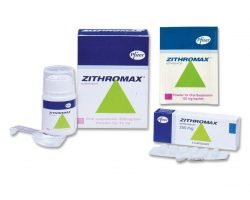Zithromax is a medication belonging to the class of macrolide antibiotics, and drugs aimed at combatting a diversity of bacterial infections. The operation of this means is the principle of stopping bacteria growth. It is used and prescribed exclusively for bacterial disorders treatment but not against viral infections overcoming.
[ithshop code=”zithromax” tpl=”short” page_id=”776″ dummy=”txt”]
Zithromax shows high effectiveness in the treatment of:
- staphylococci;
- streptococci;
- pneumococci;
- Haemophilus influenzae;
- Escherichia coli;
- enterococci;
- salmonella;
- shigella.
In addition, it can be used to successfully combat mycoplasma and bacteroids. Bactericidal action of erythromycin is manifested in case of its use in high concentration.
Indications
This drug is also effective in the treatment of sexually transmitted diseases, successfully fighting bacteria such as gonococcus, Trichomonas, Chlamydia, and spirochetes. Other diseases caused by bacteria sensitive to the drug Zithromax may also be treated with it. Such diseases include:
- a sore throat;
- bronchitis;
- otitis;
- pneumonia;
- scarlet fever;
- infected dermatitis;
- erysipelas;
- urethritis;
- other infectious diseases caused by bacteria.
Pharmacokinetics
Absorption. It is rapidly absorbed from gastrointestinal tract, due to its stability in an acidic medium and lipophilicity. After oral administration of 500 mg, maximum concentration in plasma is reached after 2.5 hours, -2.96 and 0.4 mg / l. Bioavailability is 37%.
Distribution
 Zithromax enters respiratory tract, genitourinary organs and tissues (in particular in prostate gland), the skin and soft tissue well. The high concentration in tissues (10-50 times higher than in blood plasma) and a long half-life of Zithromax are explained by its ability to bind with plasma proteins, and its to penetrate into eukaryotic cells concentrated in a low pH – environment, surrounding lysosomes. This, in turn, it defines a large apparent volume of distribution (31.1 l / kg) and high plasma clearance.
Zithromax enters respiratory tract, genitourinary organs and tissues (in particular in prostate gland), the skin and soft tissue well. The high concentration in tissues (10-50 times higher than in blood plasma) and a long half-life of Zithromax are explained by its ability to bind with plasma proteins, and its to penetrate into eukaryotic cells concentrated in a low pH – environment, surrounding lysosomes. This, in turn, it defines a large apparent volume of distribution (31.1 l / kg) and high plasma clearance.
The ability of erythromycin to accumulate mainly in lysosomes is particularly important to eliminate intracellular pathogens. It proved that phagocytes deliver azithromycin to infection localization where it is released in process of phagocytosis. The concentration in infection sites was significantly higher than in healthy tissue (on average 24-34%) and correlates with inflammatory edema. Despite the high concentration in phagocytes, Zithromax has no significant effect on their function.
Azithromycin remains in bactericidal concentrations of inflammation within 5-7 days after the last dose, which allowed the development of short courses of treatment (3-day and 5-day).
Withdrawal
Excretion of this antibiotic from plasma passes in 2 stages: half-life of 14-20 hours in the period of 8 to 24 hours after application, and 41 h – in the period from 24 to 72 hours. This fact allows taking medication 1 time per day.
Zithromax from My Canadian Pharmacy is considered to be one of the most efficient medications applied for bacterial disorders treatment. Our online pharmacy offers you decreased price for this medication. It is time to place an order and start taking care of your health.
Posted by Dr. Himanshu Singh

 English
English Deutsch
Deutsch Français
Français Italiano
Italiano Español
Español Svenska
Svenska Português
Português 日本人
日本人 Dansk
Dansk Norsk
Norsk Suomi
Suomi Czech
Czech


